Transport of H2S and HS(-) across the human red blood cell membrane: rapid H2S diffusion and AE1-mediated Cl(-)/HS(-) exchange
- PMID: 23864610
- PMCID: PMC4042536
- DOI: 10.1152/ajpcell.00178.2013
Transport of H2S and HS(-) across the human red blood cell membrane: rapid H2S diffusion and AE1-mediated Cl(-)/HS(-) exchange
Abstract
The rates of H2S and HS(-) transport across the human erythrocyte membrane were estimated by measuring rates of dissipation of pH gradients in media containing 250 μM H2S/HS(-). Net acid efflux is caused by H2S/HS(-) acting analogously to CO2/HCO3(-) in the Jacobs-Stewart cycle. The steps are as follows: 1) H2S efflux through the lipid bilayer and/or a gas channel, 2) extracellular H2S deprotonation, 3) HS(-) influx in exchange for Cl(-), catalyzed by the anion exchange protein AE1, and 4) intracellular HS(-) protonation. Net acid transport by the Cl(-)/HS(-)/H2S cycle is more efficient than by the Cl(-)/HCO3(-)/CO2 cycle because of the rapid H2S-HS(-) interconversion in cells and medium. The rates of acid transport were analyzed by solving the mass flow equations for the cycle to produce estimates of the HS(-) and H2S transport rates. The data indicate that HS(-) is a very good substrate for AE1; the Cl(-)/HS(-) exchange rate is about one-third as rapid as Cl(-)/HCO3(-) exchange. The H2S permeability coefficient must also be high (>10(-2) cm/s, half time <0.003 s) to account for the pH equilibration data. The results imply that H2S and HS(-) enter erythrocytes very rapidly in the microcirculation of H2S-producing tissues, thereby acting as a sink for H2S and lowering the local extracellular concentration, and the fact that HS(-) is a substrate for a Cl(-)/HCO3(-) exchanger indicates that some effects of exogenous H2S/HS(-) may not result from a regulatory role of H2S but, rather, from net acid flux by H2S and HS(-) transport in a Jacobs-Stewart cycle.
Keywords: AE1; erythrocyte; hydrogen sulfide; sulfide anion; transport.
Figures
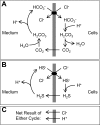
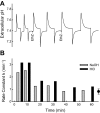
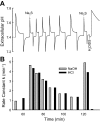
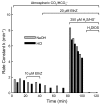

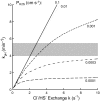
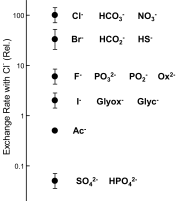
Similar articles
-
Cytosolic H+ microdomain developed around AE1 during AE1-mediated Cl-/HCO3- exchange.J Physiol. 2011 Apr 1;589(Pt 7):1551-69. doi: 10.1113/jphysiol.2010.201483. Epub 2011 Feb 7. J Physiol. 2011. PMID: 21300752 Free PMC article.
-
Deficient HCO3- transport in an AE1 mutant with normal Cl- transport can be rescued by carbonic anhydrase II presented on an adjacent AE1 protomer.J Biol Chem. 2003 Nov 7;278(45):44949-58. doi: 10.1074/jbc.M308660200. Epub 2003 Aug 21. J Biol Chem. 2003. PMID: 12933803
-
Mouse Ae1 E699Q mediates SO42-i/anion-o exchange with [SO42-]i-dependent reversal of wild-type pHo sensitivity.Am J Physiol Cell Physiol. 2008 Aug;295(2):C302-12. doi: 10.1152/ajpcell.00109.2008. Epub 2008 May 14. Am J Physiol Cell Physiol. 2008. PMID: 18480299 Free PMC article.
-
Cell physiology and molecular mechanism of anion transport by erythrocyte band 3/AE1.Am J Physiol Cell Physiol. 2021 Dec 1;321(6):C1028-C1059. doi: 10.1152/ajpcell.00275.2021. Epub 2021 Oct 20. Am J Physiol Cell Physiol. 2021. PMID: 34669510 Free PMC article. Review.
-
Anion transport systems in the plasma membrane of vertebrate cells.Biochim Biophys Acta. 1986 Jun 12;864(1):1-31. doi: 10.1016/0304-4157(86)90014-6. Biochim Biophys Acta. 1986. PMID: 3521744 Review.
Cited by
-
A Synthetic Supramolecular Receptor for the Hydrosulfide Anion.Angew Chem Int Ed Engl. 2016 Sep 12;55(38):11480-4. doi: 10.1002/anie.201605757. Epub 2016 Aug 11. Angew Chem Int Ed Engl. 2016. PMID: 27510286 Free PMC article.
-
Buffering Adaptive Immunity by Hydrogen Sulfide.Cells. 2022 Jan 19;11(3):325. doi: 10.3390/cells11030325. Cells. 2022. PMID: 35159135 Free PMC article. Review.
-
Hydrogen Sulfide and the Kidney.Adv Exp Med Biol. 2021;1315:17-50. doi: 10.1007/978-981-16-0991-6_2. Adv Exp Med Biol. 2021. PMID: 34302687
-
Biosynthesis, Quantification and Genetic Diseases of the Smallest Signaling Thiol Metabolite: Hydrogen Sulfide.Antioxidants (Basel). 2021 Jul 1;10(7):1065. doi: 10.3390/antiox10071065. Antioxidants (Basel). 2021. PMID: 34356298 Free PMC article. Review.
-
Sulfur as a signaling nutrient through hydrogen sulfide.Annu Rev Nutr. 2014;34:171-205. doi: 10.1146/annurev-nutr-071813-105654. Annu Rev Nutr. 2014. PMID: 25033061 Free PMC article. Review.
References
Publication types
MeSH terms
Substances
Grants and funding
LinkOut - more resources
Full Text Sources
Other Literature Sources
Miscellaneous

